by Luke Greiner
May 2019
Almost 20,000 workers with a disability call Central Minnesota home. Although they may seem like a relatively small part of a regional labor force with nearly 400,000 workers, workers with disabilities, or rather different abilities, contribute to the economy in a big way. In the region 5.4 percent of prime working age workers identify as having at least one disability. This has important consequences for individuals and businesses, especially considering the growing number of people with disabilities in the region. However, workers with different abilities also have an unemployment rate that is twice that of the overall rate in Central Minnesota.
One of the best benefits of a growing, healthy economy is the way employment opportunities extend to those who might have barriers to entering or succeeding in the labor market. Business cycles constantly rebalance the scales of competitive negotiating power. During a recession hiring power transfers to employers as a surplus labor force becomes eager to secure limited job opportunities. In an expanding economy with a tight labor market job seekers gain the upper hand as employers become challenged to hire from a limited number of available workers.
The latter situation is currently playing out for workers in Central Minnesota and the rest of the country. The lower unemployment rates reflect increasing employment opportunities for several segments of the labor force, including people with disabilities. Figure 1 illustrates how unemployment rates for workers with disabilities in Central Minnesota has dropped from 13.4 percent in 2012 to 8.2 percent by 2017.
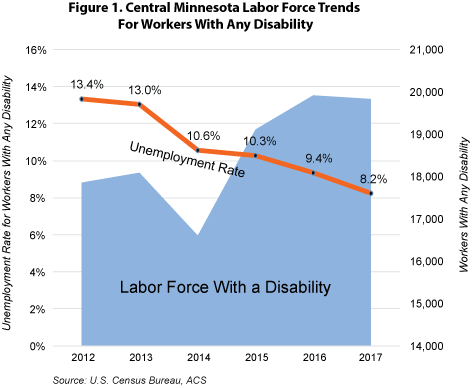
Make no mistake, the improvement in labor market outcomes for workers with disabilities is excellent. But it's important to note that the overall unemployment rate was also falling during this time as the economy recovered jobs lost during the recession. The overall unemployment rate dropped from 7.4 percent in 2012 to 4.1 percent in 2017, an even faster decline than for workers with disabilities.
During the same timeframe the labor force with any disability grew by more than 11 percent, amounting to an additional 1,976 workers, climbing to 19,838 workers in 2017. The labor force growth from this segment of the population stands in stark contrast to the modest overall growth of 1.8 percent from 2012 to 2017. For perspective, in the most recent five year period for which there are data, three in 10 new workers have some type of self-identified disability.
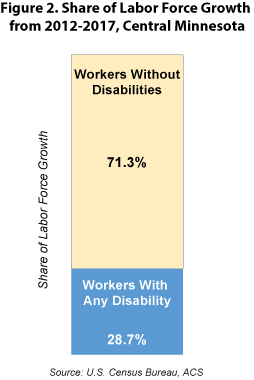
But who are these workers with differing abilities?
Data in this article are derived from the U.S. Census Bureau, which uses Americans with Disabilities Act (ADA) definitions to classify disabilities. In the context of the ADA, "disability" is a legal term rather than a medical one. Because it has a legal definition, the ADA's definition of disability is different than how it is defined under some other laws, such as for Social Security Disability-related benefits.
The ADA defines a person with a disability as a person who has a physical or mental impairment that substantially limits one or more major life activities. This includes people who have a record of such an impairment, even if they do not currently have a disability. It also includes individuals who do not have a disability but are regarded as having a disability.1
The Census Bureau collects data on disabilities in six categories:
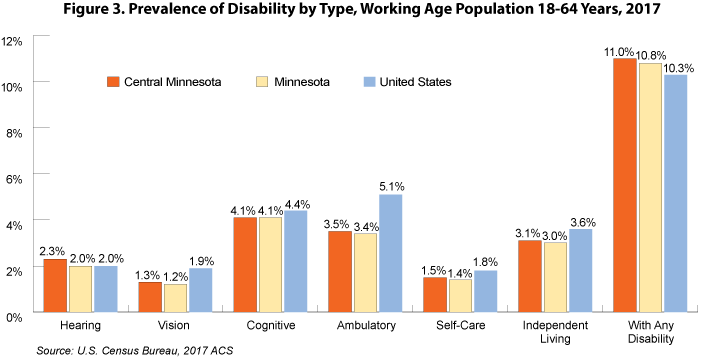
Luke Hartog, a rehabilitation counselor with DEED's Vocational Rehabilitation Services (VRS), offered some insight on how employers and individuals can team together, possibly with help from a VRS counselor, to ensure individuals skills and abilities can be utilized in the workplace. Accommodations can often help workers with different abilities succeed at work, while also helping employers recruit and retain valuable employees. "Individuals team up with vocational services to develop job goals matching their skills, abilities, and interests. Once their goals are established we implement supports ranging from training, job coaching, job search assistance, setting up job accommodations, and retention services. Individuals with different abilities are able to secure competitive jobs ranging from entry level to doctoral requirements," explained Hartog.
According to Census Bureau data, the most common type of disability for working age people (18 to 64 years) in Central Minnesota is cognitive. At 4.1 percent, the rate of incidences is the same as Minnesota's overall rate, but lower than the national frequency (4.4%). Hartog identified a few accommodations for workers who might have a cognitive difficulty, including but not limited to: using visual task lists, color coding, job coaching on-site and off-site, on-the-job training, and extended training time.
More than 14,500 people in the region are living with an ambulatory difficulty, making it the second most common disability for working age residents of Central Minnesota. According to Hartog, accommodations to help ensure success of employees in this area could include: providing desktops that are high enough to accommodate wheelchairs, installing hand-rails/grab rails in hallways, locating work space on the first floor, ensuring sidewalks and doorways are free of large lips/bumps, or removing raised floor mats that could lead to tripping.
Hearing difficulties impact more than 9,500 working age people in the region. Possible accommodations to help ensure workplace success could include: texting; easy email access; amplification devices such as FM systems;2 CapTel (caption telephones); dry erase/boogie boards;3 ASL interpreters for onboarding and important meetings; printed out meeting agendas; smart phone applications such as Marco Polo, Glide, and Stratos; Video Relay Interpreting Service; and use of lights/signs for safety.
Sometimes individuals face multiple employment barriers because of one or more disabilities. Clever, creative, and oftentimes simple solutions are one way to overcome barriers and maximize productivity and job satisfaction. Customizing job functions can allow for a wider range of employment opportunities to be accessed by people with different abilities, which is an approach that some companies are taking to maximize their talent pool and increase job satisfaction. Hartog mentioned that recently "a customer call center allowed an individual who uses a wheelchair to work from home. Working from home addressed transportation limits, self-care needs, and accessibility."
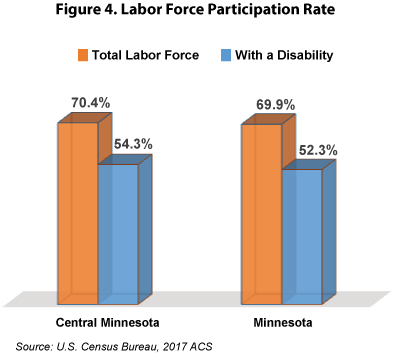
We are making progress, but participation in the labor force is still significantly lower for people with different abilities. As of 2017 the labor force participation rate was 54 percent for people with disabilities in Central Minnesota compared to 70 percent for the overall population (see Figure 4). To be sure, the extent of abilities can be drastically different for people who identify as having one or more disabilities. Statewide and local data suggest that even though labor force growth attributed to this sub-population is substantial, it's not necessarily that disabled workers see better or more job opportunities and increasingly join the labor force at higher rates.
Instead, the influx of workers with disabilities is at least partly a function of an increasing numbers of people with a disability, not increasing participation in the labor force. The labor force participation rates for people with any disability has remained basically constant since the end of the Great Recession (see Figure 5).
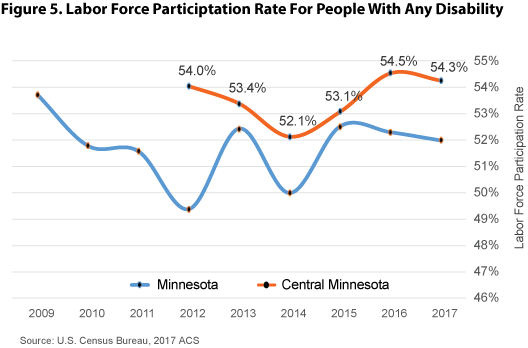
Workers with different abilities are playing an increasingly important role in the labor force. The number of people with some type of self-identified disability has risen three times faster than the overall population growth in Central Minnesota, yet their participation in the labor force remains constant. This means a larger share of the population is not yet engaged in work, and with a tight labor market and slow labor force growth projected in the future, understanding the barriers and accommodating workers of all abilities is one strategy to tap underutilized workers.
| This spring a CareerForce location (formerly known as Workforce Center) held a job fair with a focus on hiring people with disabilities as well as open for all job seekers. The job fair was a follow-up effort to a conference that focused on how to hire and employ workers with disabilities. The intent was to help match a talent pool that is twice as likely to be unemployed as the overall labor force. Unfortunately, the vast majority of businesses that were initially interested in registering for the job fair backed out after being informed of the emphasis on hiring workers with disabilities. It appears that despite low rates of unemployment and Now Hiring signs proliferating in storefronts, businesses are still cautious or reluctant to engage this population. |
1Census did not provide any examples of this situation.